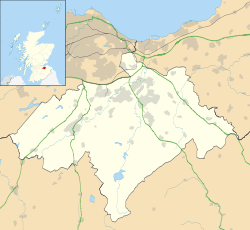Glencorse
Coordinates: 55°51′03″N 3°12′15″W / 55.8507°N 3.2042°W
Glencorse is a parish of Midlothian, Scotland, lying 7 miles south of Edinburgh.[1] It is bounded on the north-west by the former parish of Colinton now within the City of Edinburgh, to the north and west by Lasswade and to the south and west by Penicuik.
The parish is in the northern part of the Penicuik and District Community Council area [2] and includes the village of Auchendinny near its eastern boundary.[3]
The parish is traversed from west to east by Glencorse Burn, part of whose valley contains Glencorse Reservoir, which was formed in 1819-28 by damming the burn’s glen with a huge embankment 130 ft high.[3] The reservoir is a source of Edinburgh’s water supply. Also in the parish are Glencorse Barracks, Bush House, Glencorse House, Woodhouselee and Easter Howgate. The northern part of the parish includes some of the Pentland Hills and the highest point within the parish is Turnhouse Hill (1403 ft).[1][4]
The parish is divided between two Scottish Parliamentary constituencies: Midlothian North and Musselburgh to the north of Glencorse burn and Midlothian South, Tweeddale and Lauderdale south of the burn.[5]
The parish of Glencorse was formed in 1616 from the ancient parishes of Pentland and Penicuik, the northern part being taken from the parish of Pentland (barony 0f Fulford) and the southern part from Penicuik. The parish was originally named after St. Catherine, because of the chapel dedicated to her which stood in the valley of Glencorse burn, now submerged under the reservoir.[6]

After the 17th century parish church burned down,[3] a new one (now known as Glencorse Old Kirk) was built 1665 with the north and south aisles being added in 1699. The building is now roofless, having been superseded by a much larger church.[7] The previous church of Glencorse became too small for the parish due to the increased numbers of troops at Glencorse Barracks. Robert Trotter, of Bush House, donated funds for a new building and a site to use as a cemetery, namely a field at New Milton farm. The new church was erected in 1885. The font was found in the floor of the Old Kirk during renovations in 1811 and is thought to have originally come from the Chapel of St Catherine, which was flooded during the creation of the Glencorse Reservoir.[8]
A Parochial Board was established under the Poor Law (Scotland) Act 1845. With the Local Government (Scotland) Act 1894 the Parish Council was established, which continued until 1930 when parish councils in Scotland were abolished,.[9] Civil parishes persist for census and other non-administrative purposes.
The civil parish has an area of 4245 acres [1] and a population of 5,293 (in 2011).[10]
References
- 1 2 3 Gazetteer of Scotland, publ, by W & AK Johnston, Edinburgh, 1937. Article on Glencorse. Places are presented alphabetically
- ↑ Midlothian council web site https://midlothian.cmis.uk.com/live/CommunityCouncils.aspx - see entry for Penicuik and District. Retrieved April 2016
- 1 2 3 Gazetteer of Scotland, 2nd edition, by W. Groome, publ. 1896. Article on Glencorse
- ↑ The Statistical Account of Edinburghshire, by the Ministers of the Respective Parishes, publ. William Blackwood and Sons, Edinburgh, 1845. Article on Glencorse, p.310
- ↑ Midlothian Council Polling Station maps http://www.midlothian.gov.uk/info/802/voting/924/polling_stations (see map for Midlothian West) retrieved April 2016
- ↑ Topographical, Statistical, and Historical Gazetteer of Scotland (articles on Glencross and Pentland), publ. A. Fullarton & Co., Edinburgh, 1853
- ↑ The Architecture of Scottish post-Reformation churches, 1560-1843, by G. Hay, publ. Oxford, 1957, pp. 49-50
- ↑ Historic Scotland’s web site for Listed Buildings http://portal.historic-scotland.gov.uk/designation/LB7456 retrieved April 2016
- ↑ Local Government (Scotland) Act 1929
- ↑ Census of Scotland 2011, Table KS101SC – Usually Resident Population, publ. by National Records of Scotland. Web site http://www.scotlandscensus.gov.uk/ retrieved March 2016. See “Standard Outputs”, Table KS101SC, Area type: Civil Parish 1930
-
